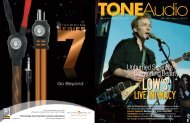Create successful ePaper yourself
Turn your PDF publications into a flip-book with our unique Google optimized e-Paper software.
MUSIC<br />
142 TONE AUDIO NO.64<br />
A<br />
trio may be the most challenging format for a jazz<br />
saxophonist. The player has no place to hide. He or<br />
she can’t play off of another horn’s ideas, and there’s<br />
no piano to provide a cushion of chords. In some<br />
ways, it’s even more daring than performing solo<br />
because the leader still must engage and inspire a<br />
rhythm section.<br />
Joshua Redman<br />
Trios Live<br />
Nonesuch, CD<br />
Joshua Redman began<br />
recording with this kind of group<br />
about seven years ago. His 2007<br />
Back East album features the<br />
trio at its core (including bassist<br />
Reuben Rogers, who returns<br />
here on three tracks), but it also<br />
includes a number of guest<br />
players. Since then, he’s worked<br />
with the collaborative James<br />
Farm and orchestral Walking<br />
Shadows. On the new Trios Live,<br />
he goes back to the strippeddown<br />
setting for this concert<br />
recording of two different groups<br />
performing at New York’s Jazz<br />
Standard and Washington, D.C.’s<br />
Blues Alley. Getting back to the<br />
basics and taking on this dare<br />
in front of discerning audiences<br />
makes his playing sound stronger<br />
than ever.<br />
Redman has mentioned that<br />
Sonny Rollins’ classic trio dates,<br />
especially 1957’s Way Out West,<br />
have been especially inspirational<br />
when he began working within<br />
the format. While those are large<br />
shoes to fill, Redman, on tenor<br />
and soprano, sounds more<br />
than up to the job, especially<br />
since he consistently displays a<br />
personality of his own.<br />
The way Redman, bassist<br />
Matt Penman, and drummer<br />
Gregory Hutchinson approach<br />
Kurt Weill’s “Moritat (Mack The<br />
Knife)” can be considered the<br />
most ostensible connection to<br />
Rollins. They extend the piece,<br />
and Redman in particular fills<br />
it with an array of squeals and<br />
clever quotations. Hutchinson,<br />
especially, helps guide all these<br />
forays into a resolving logic; Redman’s<br />
rich tone also emphasizes<br />
this sense of clarity. A power take<br />
on Thelonious Monk’s “Trinkle,<br />
Tinkle” steamrolls through the<br />
composer’s singular intervals—<br />
a piano may have slowed them<br />
down. The saxophonist’s voice<br />
is equally convincing on such<br />
quiet pieces as Jay Livingston’s<br />
ballad “Never Let Me Go,” which<br />
features Redman’s subtle vibrato<br />
and subtly bold upper-register<br />
harmonies.<br />
Trios Live also serves as a reminder<br />
of Redman’s considerable<br />
skills as a composer. His “Mantra<br />
#5” provides the ideal structure<br />
for his soprano lyricism. “Act<br />
Natural” sounds like a multipart<br />
suite with Rogers’ pizzicato bass<br />
solo leading back to Redman’s<br />
embellishment of the theme with<br />
growls that hang outside the bar<br />
lines. Hutchinson also brings in<br />
different, and surprising, melodic<br />
tones here, as well as on “Soul<br />
Dance.”<br />
A rousing version of Led Zeppelin’s<br />
“The Ocean” concludes<br />
the outing. Redman, Penman,<br />
and Hutchinson bring the funk<br />
and unleash a few gimmicks—<br />
like the saxophonist’s slap tonguing.<br />
But, considering the source,<br />
throwing every fun trick in the<br />
service of Zeppelin is more than<br />
all right. —Aaron Cohen<br />
July 2014 143




